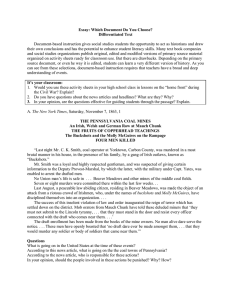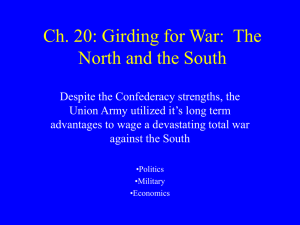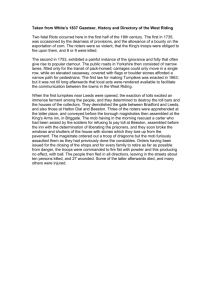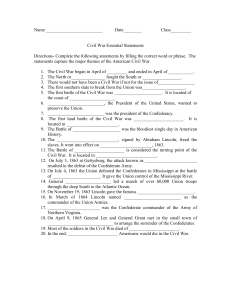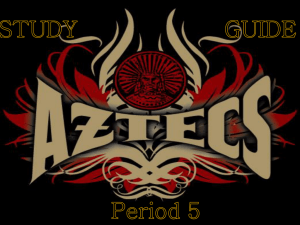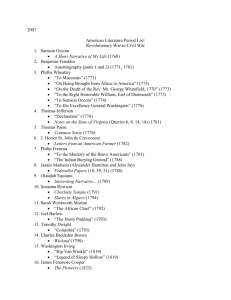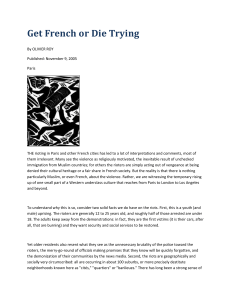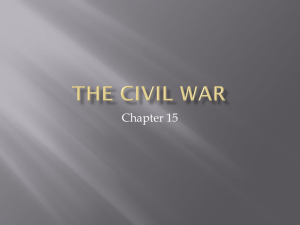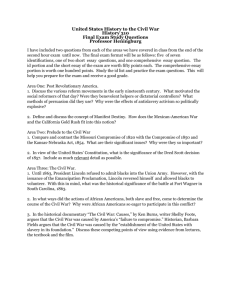TITLE: The New York Draft Riots (Social Studies, Grade 7/8... NEW YORK STATE SOCIAL STUDIES STANDARDS: United States History (1.1,...
advertisement
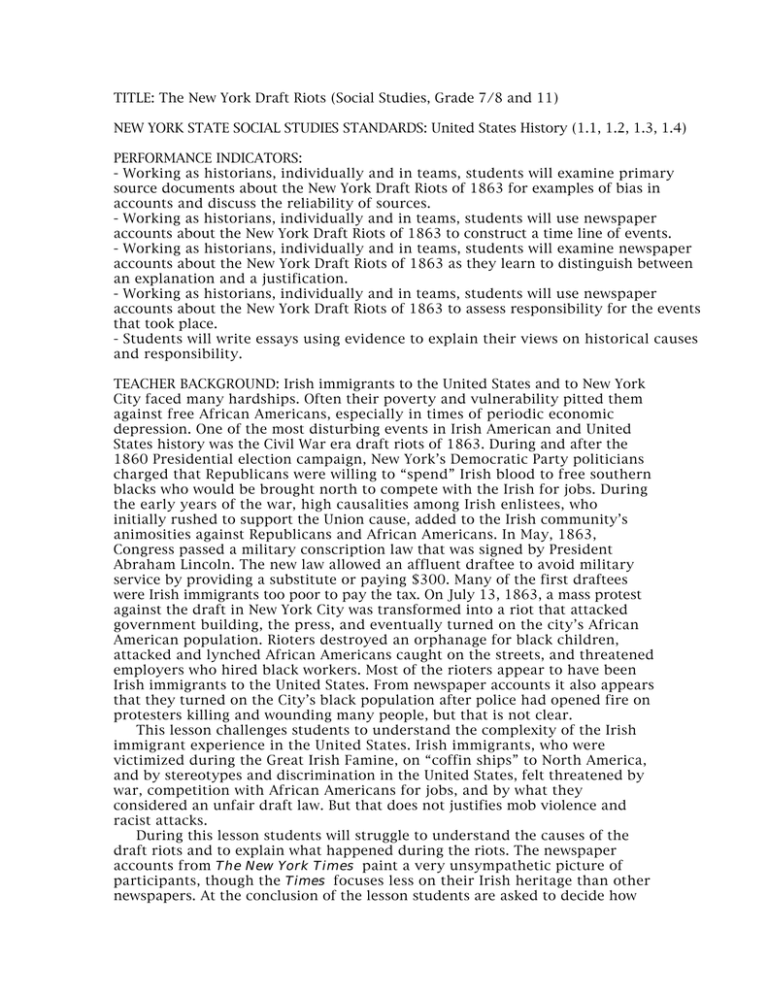
TITLE: The New York Draft Riots (Social Studies, Grade 7/8 and 11) NEW YORK STATE SOCIAL STUDIES STANDARDS: United States History (1.1, 1.2, 1.3, 1.4) PERFORMANCE INDICATORS: - Working as historians, individually and in teams, students will examine primary source documents about the New York Draft Riots of 1863 for examples of bias in accounts and discuss the reliability of sources. - Working as historians, individually and in teams, students will use newspaper accounts about the New York Draft Riots of 1863 to construct a time line of events. - Working as historians, individually and in teams, students will examine newspaper accounts about the New York Draft Riots of 1863 as they learn to distinguish between an explanation and a justification. - Working as historians, individually and in teams, students will use newspaper accounts about the New York Draft Riots of 1863 to assess responsibility for the events that took place. - Students will write essays using evidence to explain their views on historical causes and responsibility. TEACHER BACKGROUND: Irish immigrants to the United States and to New York City faced many hardships. Often their poverty and vulnerability pitted them against free African Americans, especially in times of periodic economic depression. One of the most disturbing events in Irish American and United States history was the Civil War era draft riots of 1863. During and after the 1860 Presidential election campaign, New York’s Democratic Party politicians charged that Republicans were willing to “spend” Irish blood to free southern blacks who would be brought north to compete with the Irish for jobs. During the early years of the war, high causalities among Irish enlistees, who initially rushed to support the Union cause, added to the Irish community’s animosities against Republicans and African Americans. In May, 1863, Congress passed a military conscription law that was signed by President Abraham Lincoln. The new law allowed an affluent draftee to avoid military service by providing a substitute or paying $300. Many of the first draftees were Irish immigrants too poor to pay the tax. On July 13, 1863, a mass protest against the draft in New York City was transformed into a riot that attacked government building, the press, and eventually turned on the city’s African American population. Rioters destroyed an orphanage for black children, attacked and lynched African Americans caught on the streets, and threatened employers who hired black workers. Most of the rioters appear to have been Irish immigrants to the United States. From newspaper accounts it also appears that they turned on the City’s black population after police had opened fire on protesters killing and wounding many people, but that is not clear. This lesson challenges students to understand the complexity of the Irish immigrant experience in the United States. Irish immigrants, who were victimized during the Great Irish Famine, on “coffin ships” to North America, and by stereotypes and discrimination in the United States, felt threatened by war, competition with African Americans for jobs, and by what they considered an unfair draft law. But that does not justifies mob violence and racist attacks. During this lesson students will struggle to understand the causes of the draft riots and to explain what happened during the riots. The newspaper accounts from The New York Times paint a very unsympathetic picture of participants, though the Times focuses less on their Irish heritage than other newspapers. At the conclusion of the lesson students are asked to decide how they would cast their ballots if they were sitting on a jury trying rioters for murder and other crimes. SUPPLIES: Activity Sheet A: The New York Times, Headlines, 1863 and Activity Sheet B: The New York Times Covers Civil War Draft Riots DESCRIPTION OF LESSON: This lesson challenges students to understand the complexity of the Irish immigrant experience in the United States, particularly during the Civil War era and to think as historians as they evaluate evidence from the past. As an introductory activity, students work individually, examining a series of headlines from The New York Times. The headlines mention the new draft law and briefly describe the draft riots. Students are asked to write what happened in New York City between July 13 and July 18, 1863 and to explain why it happened? As a motivation, students discuss whether protest is legitimate during a time of war and whether a riot, or even violence, is justified if you feel your rights are being violated or you are under attack. After a general discussion, students discuss what they uncovered looking at the headlines. During the rest of the lesson, which can last for one or two days, student teams examine excerpts from articles from The New York Times that discuss the conscription law and the riots. Student teams are asked to answer some general questions and questions that accompany each selection. Teams can decide to have all members read each article or to divide the articles up among team members. Before beginning the class discusses the job of the historian. Historians often use newspaper accounts from the past to understand events. However, newspaper accounts have to be read with a critical eye. Historians continually ask themselves questions like: Are these article based on eyewitness accounts? Are the witnesses reliable? Are they telling the full story? Do the editorials and news article reflect the biases of the newspaper? articles up among team members. After reading the articles, student teams construct a timeline of events, discuss the accuracy and biases of the reports, whose voice is included, whose voice is missing, and if there is anything that makes them question the accounts. Teams should discuss why people would protest during a time of war. Why did protests turn into riots? What actions, if any, should be taken against people who participated in the riots? At the end of the period, the entire class will discuss if a jury trying rioters for murder and other crimes, should find them guilty based on the evidence provided. AIM QUESTION: Why were there draft riots in New York City during the Civil War? DO NOW ACTIVITY: Examine Activity Sheet A: The New York Times, Headlines, 1863 MOTIVATIONAL ACTIVITY: Is protest legitimate during a time of war? Is rioting or violence justified if you feel your rights are being violated or you are under attack? TRANSITIONAL ACTIVITY: Discuss the headlines from The New York Times. Based on what you have seen so far, were people justified in protesting against the draft in a time of war? In your opinion, how does a protest become a riot? ACTIVITY: Discuss, how do historians decide if newspaper reports from the past are reliable as evidence? ACTIVITY: Working in teams, student complete ACTIVITY SHEET B: The New York Times Covers Civil War Draft Riots. SUMMARY QUESTION: Why did protests turn into riots? What actions, if any, should be taken against people who participated in the riots? HOMEWORK ASSIGNMENT: Write an essay discussing the question, “If you were sitting on a jury trying rioters for murder and other crimes, would you find them guilty based on the evidence provided here? Why? Be sure to refer directly to the article from The New York Times. ASSESSMENT: Student learning will be assessed based on the quality of their performance in groups, there participation in full class activities, their written homework assignment and class presentations. REFLECTION: History is messy. It can be very difficult for students to balance empathy for both Irish and African Americans generated during previous lessons with the events taking place during the Civil War. It is especially difficult to understand that explaining an event does not mean you are justifying it. During the lesson, teachers have to be sensitive to racial and ethnic tensions and stereotyping in their classes. A teacher may decide to use a lesson like this to explore current tensions in our society and their impact on our class as a community of learners and historians. Students can compare the Civil War era draft riot with other protests and riots in United States history and discuss ways that groups and mobs, once incited by police action or leaders, can take on a life of their own. As a follow-up activity, students can research and write reports on the history of racial and ethnic conflicts in the United States and movements like the Populist Party, the labor movement and the Civil Rights movement that tried to bridge differences between groups and build strong alliances. SUPPLEMENTARY READING: To learn more about the historic relationship between Irish Americans and African Americans, see Ronald Takaki, A Different Mirror: A History of Multicultural America (Boston: Little, Brown, 1993). The riots are discussed in detail in Ivar Bernstein, The New York City Draft Riots, Their Significance for American Society and Politics in the Age of the Civil War (New York, 1990). Activity Sheet 1 The New York Times, Headlines, 1863 Examine the following headlines from The New York Times. 1- What happened in New York City between July 13 and July 18, 1863? 2- In your opinion, why did it happen? THE CONSCRIPTION LAW. IMPORTANT PROCLAMATION BY THE PRESIDENT. May 9, 1863, p. 1 THE DRAFT BEGINS. July 11, 1863, p. 3 THE MOB IN NEW YORK. RESISTANCE TO THE DRAFT -- RIOTING AND BLOODSHED. CONSCRIPTION OFFICES SACKED AND BURNED. PRIVATE DWELLINGS PILLAGED AND FIRED. AN ARMORY AND A HOTEL DESTROYED. COLORED PEOPLE ASSAULTED -- AN UNOFFENDING BLACK MAN HUNG. THE TRIBUNE OFFICE ATTACKED ---THE COLORED ORPHAN ASYLUM RANSACKED AND BURNED --- OTHER OUTRAGES AND INCIDENTS. A DAY OF INFAMY AND DISGRACE. July 14, 1863, p. 1 THE REIGN OF THE RABBLE. LARGE NUMBERS KILLED. STREETS BARRICADED, BUILDINGS BURNED. July 15, 1863, p. 1 ANOTHER DAY OF RIOTING. MOBS ARMED WITH RIFLES. NEGROES HUNG. July 16, 1863, p. 1 THE RIOTS SUBSIDING. TRIUMPH OF THE MILITARY. July 17, 1863, p. 1 QUIET RESTORED. CONTINUED PRECAUTIONS OF AUTHORITIES. July 18, 1863, p. 1 THE DRAFT HERE AND ELSEWHERE. THE LAWS AND THE MOB. AID FOR THE INJURED. JUSTICE TO THE VICTIMS. July 18, 1863, p. 1 THE LAW OF THE DRAFT. THE QUESTION OF EXEMPTIONS. July 19, 1863 Activity Sheet 2 The New York Times Covers Civil War Draft Riots Historians often use newspaper accounts from the past to understand events. However, newspaper accounts have to be read with a critical eye. Historians continually ask themselves questions like: Are these article based on eyewitness accounts? Are the witnesses reliable? Are they telling the full story? Do the editorials and news article reflect the biases of the newspaper? Because these articles are over one hundred years old, language and spelling are sometimes different from today. Team Instructions 1- Working in teams of historians, examine the excerpts from the articles and editorials from The New York Times and answer the questions that follow each passage. Your team can decide to have all members read each article or to divide the articles up among team members. 2- Use the newspaper articles to construct a time line of events. 3- Teams should discuss the accuracy and biases of the reports. Whose voice is included in these excerpts? Whose voice is missing? Is there anything that makes you question the accounts? Explain. 3- Teams should discuss why people would protest during a time of war. Why did protests turn into riots? What actions, if any, should be taken against people who participated in the riots? 4- If you were sitting on a jury trying rioters for murder and other crimes, would you find them guilty based on the evidence provided here? Be prepared to explain your views to the class. A) A New York Times Editorial, Friday, February 20, 1863 “The Conscription Act, which has just passed the Senate, is the greatest pledge yet given that our government means to prevail, and will prevail. It is really the first assertion of a purpose to command the means of its own preservation. . . We say (it) is the best of all guarantees of its final success.” 1- What does this editorial discuss? 2- How does an editorial differ from a news article? 3- What is The New York Times’ position on this issue? B) A New York Times Editorial, Friday, July 10, 1863 “ The Administration is acting wisely in ordering the immediate enforcement of the draft . . . The conscription is necessary. Even after the late great victories, a new army of 800,000 men must get ready to move upon the Confederacy. Let the rebel States see that not only are they beaten now by the forces at present in the field, but that in the Fall they meet the same veteran armies 800,000 stronger.” 1- This editorial was printed the day before the draft was scheduled to begin. What opinion is expressed by The New York Times in this editorial? 2- In your opinion, why does The New York Times take this position? C) The Draft -- Regulations, Saturday, July 11, 1863 “All able-bodied male citizens of the United States and persons of foreign birth who shall have declared on oath their intention to become citizens . . . . between the ages of 20 and 45, with certain exceptions, to be subject to draft.” “Any person drafted and notified to appear may, on or before the day fixed for his appearance, furnish an acceptable substitute to take his place in the draft, or he may pay to the Commissioner of Internal Revenue . . . the sum of $300.” 1234- According to this article, who is eligible for the draft? How can a man avoid serving in the military? In your opinion, are these exemptions fair? Explain. In your opinion, who might object to this plan? Why? D) The Attack on the Armory in Second Avenue, July 14, 1863 (part 1) “At about 4 o’clock the crowd proceeded from . . . Lexington Avenue and Forty-fourth street to the armory situated on the corner of Second Avenue and Twenty-first street. The building was a large four story one, and was occupied for the manufacture of rifles for the Government. In the early part of the day the police authorities had placed in the building a large number of Policemen. Their instructions were to protect the building and the property inside, and to resist with force any attempt of the invaders to enter the premises. . . . At the time the first attempt was made to force the doors of the building, the mob amounted to from three to four thousand, the greater part of whom were boys. . . . The doors were burst open by means of heavy sledges, and the crowd made a rush to enter the building. Those in charge of the building, acting under instructions, fired upon those who were entering and four or five were wounded. One man was shot through the heart and died immediately.” 1234- According to this article, what does the “mob” do? Who is in the “mob”? How do the guards respond to the “mob”? Do you think this response was necessary? Explain. E) The Attack on the Armory in Second Avenue, July 14, 1863 (part 2) “By this time the Fire Department of the District arrived on the ground, and were preparing to work on the fire, but were prevented from doing so by the mob, who threatened them with instant death if their orders were disobeyed. The cars were stopped from running and the horses in several instances were killed. . . . The rioters meanwhile danced with fiendish delight before the burning building, while small boys sent showers of stones against the office, smashing its doors and windows. . . . The military soon appeared, but was immediately routed, they fled to the side streets.” 1- What does the “mob” do when the fire department tries to put out the fire? 2- What happens when the military arrives? 3- In your opinion, why did the crowd act like this? 4- The article describes the crowd as “fiendish.” In your opinion, is this a fair description? Explain. F) Burning of the Orphanage for Colored Children, July 14, 1863 “ The Orphan Asylum for Colored Children was visited by the mob after 4 o’clock. . . . Hundreds, and perhaps thousands of the rioters, the majority of whom were women and children, entered the premises and in the most excited and violent manner they ransacked and plundered the building from cellar to garret. . . . It was a purely charitable institution. In it there are on an average 600 or 800 homeless colored orphans. . . . After an hour and a half of labor on the part of the mob, it was in flames in all parts.” 1- In your opinion, why did the crowd attack the Orphanage for Colored Children? 2- Did the attack on the orphan happen before or after the attack on the armory? Does the sequence of events make a difference in how we explain what happened? G) Outrage Upon Colored Persons, July 14, 1863 “Among the most cowardly features of the riot was the causeless and inhuman treatment of the negroes of the City. It seemed to be an understood thing throughout the city that the negroes should be attacked wherever found. As soon as one of these unfortunate people was spied, he was immediately set upon by a crowd of men. . . . There were probably not less than a dozen negroes beaten to death in different parts of the city during the day.” 1- Who are the “colored persons” and “negroes”? 2- What was happening to them during the day? 3- In your opinion, why was the crowd seeking out “colored persons”? 4- The article says that “(I)t seemed to be an understood thing throughout the city that the negroes should be attacked.” Do you think the attacks were planned? Explain. H) Character of the Mob, July 14, 1863 “In the early part of the day yesterday, there were a number of respectable workmen and persons engaged in different occupations in the City, who were momentarily seduced from their labors and their work-shops, and went with the crowds in the street. But they at once saw the horrible character of the mob and the atrocious work they had on hand; they heard their threats and saw their shocking brutalities, and were only too glad to get out from among them. At last the mob or mobs were composed of only the vilest men in the City, and there was not a crime conceivable, from firing houses to hanging negroes, of which they were not capable. . . . Our reporter observed in one gang, several women armed with sticks . . .; but it is only justice to say that the voluble tongues of these women gave vent to their thoughts with an accentuation which was never acquired on this side of the Atlantic ocean.” 1- According to The New York Times, how did the crowd change during the day? 2- The New York Times claims that women rioters spoke with accents from across the ocean. Where do you think these women came from? Why? I) Eighteen Persons Reported Killed, July 15, 1863 “Between 12 and 1 o’clock yesterday, the rioters commenced their attack upon the Union Steam Works. . . . The rioters turned out in large force numbering from 4,000 to 5,000 people -- including children. . . . At 3 pm three hundred Policemen arrived upon the ground. . . . When the police made their appearance, the rioters attempted to escape by the rear windows, but too late. Finding themselves caught in a tight place, they made an attack on the Police. This assault the officers met by a volley from their revolvers and five of the mob were shot. . . About twenty rioters remained in the building and there was but one way for them to make their exit. The mob made a deadly assault upon the police. They in turn used their weapons effectively, and fourteen of the mob were instantly killed.” 1- What happened at the Union Steam Works? 2- What did the police do when they had part of the “mob” trapped? 3- Do you agree with these police actions? Explain. 4- Why would a violent “mob” bring along children? Does this make you question the accuracy of The New York Times report? Explain. J) Shall Ruffians Rule Us?, Editorial, July 15, 1863 “The mob yesterday was unquestionably started on the basis of resistance to the draft. But that was a very small part of the spirit which really prompted and kept it in motion. It was, probably, in point of character, the lowest and most ruffianly mob which ever disgraced our City. . . There is but one way to deal with this course brutality. It is idle to reason with it, - worse than idle to tamper with it; it must be crushed. Nothing but force can deal with its open manifestation.” 1234- How does The New York Times describe the rioters? Do you agree with this description? Explain. What does The New York Times propose to solve the problem? Do you agree with this solution? Explain. K) The Nationality of the Rioters, July 16, 1863 “The Tribune of yesterday morning had the following: ‘It is a curious fact that of all the arrests made, every one is Irish.’ However, this may be, it is a fact patent to everyone who has seen anything of the mob that it is composed exclusively of Irishmen and boys.” 1- In your opinion, what does the New York Tribune mean when it writes that it is “curious” that everyone arrested was Irish? 2- How does The New York Times respond to the statement by the New York Tribune? 3- Assume the reports are accurate. Why do you think the rioters were overwhelmingly Irish? 4- What does this article tell us about ethnic relations in New York City at that time? Explain. L) An Appeal to the Irish Catholics from Archbishop Hughes, July 16, 1863. “In the present disturbed condition of the City, I will appeal not only to them, but to all persons who love God and revere the holy Catholic religion . . . to return to their homes . . . and disconnect themselves from the seemingly deliberate intention to disturb the peace and social rights of the citizens of New York. “ - John Hughes was the Roman Catholic Archbishop of New York. In your opinion, why did he make this statement? M) The Spirit of the Mob and its Promoters, editorial, July 17, 1863 “What most amazes is not the existence of this mob, but its hideousness. . . . The rabble exhibit an abandonment of human feeling, that was hardly deemed possible in any portion of American society, even the foreign-born.” - What does The New York Times say about immigrants in this editorial? N) Speech of Archbishop Hughes, July 18, 1863 “Men of New York. They call you rioters, and I cannot see a riotous face among you. . . . I am a minister of God, and a minister of peace, who in your troubles in years past, . . . never deserted you. . . . I will not enter into the question which has provoked all this excitement. No doubt there are some real grievances. . . . If you are Irishmen, and the papers say the rioters are all Irishmen, then I also am an Irishmen, but not a rioter, for I am a man of peace.” 1- How does Archbishop Hughes address the people The New York Times described as ruffians? 2- In your opinion, why did Archbishop Hughes announce that he is both an Irishman and a man of peace? 3- Do you agree or disagree with the way Archbishop Hughes addresses the crowd? Explain.
